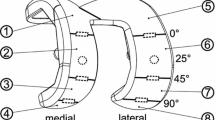Abstract
Introduction: Main reasons for the early revision of total hip arthroplasties are aseptic loosening as a result of wear debris caused by polyethylene particles, and postoperative dislocations. In revision arthroplasty of the hip metallic deposits were frequently found on femoral heads after dislocation or repositioning in total hip arthroplasties with metal back acetabular components. Materials and methods: In this study we examined ceramic femoral heads from alumina-on-alumina and alumina-on-polymer pairings, respectively. All the heads resulted from revision of total hip replacement with a titanium containing acetabular component and showed metallic deposit on their surface. The metallic deposit was characterized by environmental scanning electron microscopy, energy dispersive X-ray spectroscopy and laser scanning microscopy. Results: The metallic deposits covered areas between 5 mm2 and 8 cm2 and reached a maximum height of 30 μm. They were shown to consist of titanium, and thus resulted from contact between the femoral head and the posterior part of the metal back. In case of twofold dislocated alumina-on-alumina pairings the titanium deposits showed different roughness profiles, whereas no differences were detectable for alumina-on-polymer pairings. Conclusion: From the obtained results it can be concluded, that titanium deposited onto a femoral head during dislocation will be abraded within the harder alumina-on-alumina bearing couple during normal gait and will subsequently be released into the body by synovial fluid. In case of a ceramic-on-polymer bearing the deposited metal seems to be more harmful. The increased surface roughness of the femoral head within the tribological pairing probably initiates damage of the polymeric acetabular inlay and increases the wear of the bearing surface through a third-body wear mechanism resulting in the release of high amounts of PE.





Similar content being viewed by others
References
Bizot P, Larrouy M, Witvoet J, Sedel L, Nizard R (2000) Press-fit metal-backed alumina sockets: a minimum 5-year followup study. Clin Orthop 379:134–142
Bizot P, Nizard R, Hamadouche M, Hannouche D, Sedel L (2001) Prevention of wear and osteolysis: alumina-on-alumina bearing. Clin Orthop 393:85–93
Elke R (2001) Particle disease. Is tribology a topic in revision surgery? Orthopade 30:258–265
Green TR, Fisher J, Stone M, Wroblewski BM, Ingham E (1998) Polyethylene particles of a ‘critical size’ are necessary for the induction of cytokines by macrophages in vitro. Biomaterials 19:2297–2302
Harris WH. (1995) The problem is osteolysis. Clin Orthop 311:46–53
Haynes DR, Crotti TN, Potter AE, Loric M, Atkins GJ, Howie DW, Findlay DM (2001) The osteoclastogenic molecules RANKL and RANK are associated with periprosthetic osteolysis. J Bone Joint Surg Br 83:902–911
Haynes DR, Crotti TN, Zreiqat H (2004) Regulation of osteoclast activity in peri-implant tissues. Biomaterials 25:4877–4885
Kobayashi A, Freeman MA, Bonfield W, Kadoya Y, Yamac T, Al-Saffar N, Scott G, Revell PA (1997) Number of polyethylene particles and osteolysis in total joint replacements. A quantitative study using a tissue-digestion method. J Bone Joint Surg Br 79:844–848
Konttinen YT, Xu JW, Pätiälä H, Imai S, Waris V, Li TF, Goodman SB, Nordsletten L, Santavirta S (1997) Cytokines in aseptic loosening of total hip replacement. Curr Orthop 11:40–47
Lombardi AV Jr, Mallory TH, Vaughn BK, Drouillard P (1989) Aseptic loosening in total hip arthroplasty secondary to osteolysis induced by wear debris from titanium-alloy modular femoral heads. J Bone Joint Surg Am 71:1337–1342
Luchetti WT, Copley LA, Vresilovic EJ, Black J, Steinberg ME (1998) Drain entrapment and titanium to ceramic head deposition: two unique complications following closed reduction of a dislocated total hip arthroplasty. J Arthroplasty 13:713–717
Matthews JB, ABesong AA, Green TR, Stone MH, Wroblewski BM, Fisher J, Ingham E (2000) Evaluation of the response of primary human peripheral blood mononuclear phagocytes to challenge with in vitro generated clinically relevant UHMWPE particles of known size and dose. J Biomed Mater Res 52:296–307
Morrey BF (1992) Instability after total hip arthroplasty. Orthop Clin North Am 23:237–248
Murray DW, Rushton N (1990) Macrophages stimulate bone resorption when they phagocytose particles. J Bone Joint Surg Br 72:988–992
Rogers SD, Howie DW, Graves SE, Pearcy MJ, Haynes DR (1997) In vitro human monocyte response to wear particles of titanium alloy containing vanadium or niobium. J Bone Joint Surg Br 79:311–315
Thomsen M, Brensch SJ (2003) Mechanical strength of used ceramic femoral heads. Hip Int 13:107–112
Van Stralen GM, Struben PJ, Van Loon CJ (2003) The incidence of dislocation after primary total hip arthroplasty using posterior approach with posterior soft-tissue repair. Arch Orthop Trauma Surg 123:219–222
Willmann G (2000) The evolution of ceramics in total hip replacement. Hip Int 10:193–203
Willmann G (2002) Ceramic inserts for acetabular components of THR. In: Garino JP, Willmann G (eds) Bioceramics in joint arthroplasty. Georg Thieme Verlag, Stuttgart pp 59–64
Woo RY, Morrey BF. (1982) Dislocations after total hip arthroplasty. J Bone Joint Surg Am 64:1295–306
Yoo JJ, Kim HJ, Kim YM (2004) Damage of an alumina-on-alumina bearing surface from a difficult reduction of a total hip arthroplasty. A report of three cases. J Bone Joint Surg Am 86:376–378
Author information
Authors and Affiliations
Corresponding author
Rights and permissions
About this article
Cite this article
Müller, F.A., Hagymási, M., Greil, P. et al. Transfer of metallic debris after dislocation of ceramic femoral heads in hip prostheses. Arch Orthop Trauma Surg 126, 174–180 (2006). https://doi.org/10.1007/s00402-006-0109-6
Received:
Published:
Issue Date:
DOI: https://doi.org/10.1007/s00402-006-0109-6




